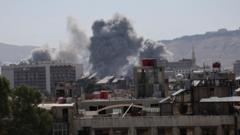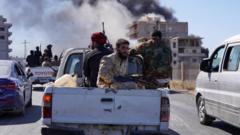Israel's actions in Damascus, aimed at Iranian militias, highlight ongoing regional instability and the delicate balance of power in the area.
Israel Conducts Airstrikes on Damascus Amid Regional Tensions

Israel Conducts Airstrikes on Damascus Amid Regional Tensions
Israeli military strikes target Syrian capital, escalating conflict while a cease-fire is declared.
The situation escalated dramatically as Israel launched a series of airstrikes on Damascus, attacking critical locations including a Syrian defense ministry compound and a zone adjacent to the presidential palace. The Israeli military confirmed the strikes, which were a response to violent altercations involving Syrian government forces in the southern Sweida region—an area significant for Syria's Druse minority, which has garnered support from Israel. Israeli officials warned of further retaliatory measures against Syrian forces unless they withdrew from Sweida.
In the aftermath of the assaults, Syrian authorities proclaimed a cease-fire agreement had been achieved with local stakeholders in Sweida, suggesting a momentary pause in hostilities. American Secretary of State Marco Rubio later stated the U.S. had engaged with all parties involved to mitigate the situation, describing it as “troubling and horrifying.”
Despite this diplomatic effort, Israeli military operations resumed later that evening with reports of further strikes targeting military installations in and around Damascus. The underlying reasons for Israel's intervention stem from concerns over Iranian-backed militias establishing a foothold near its borders and the necessity to maintain the favor of its Druse populace, who have significant historical ties with the Israeli government.
This complex scenario underscores the multifaceted challenges that the regional powers face as they navigate the shifting tides of allegiance and conflict in the often volatile Middle East.
In the aftermath of the assaults, Syrian authorities proclaimed a cease-fire agreement had been achieved with local stakeholders in Sweida, suggesting a momentary pause in hostilities. American Secretary of State Marco Rubio later stated the U.S. had engaged with all parties involved to mitigate the situation, describing it as “troubling and horrifying.”
Despite this diplomatic effort, Israeli military operations resumed later that evening with reports of further strikes targeting military installations in and around Damascus. The underlying reasons for Israel's intervention stem from concerns over Iranian-backed militias establishing a foothold near its borders and the necessity to maintain the favor of its Druse populace, who have significant historical ties with the Israeli government.
This complex scenario underscores the multifaceted challenges that the regional powers face as they navigate the shifting tides of allegiance and conflict in the often volatile Middle East.





















